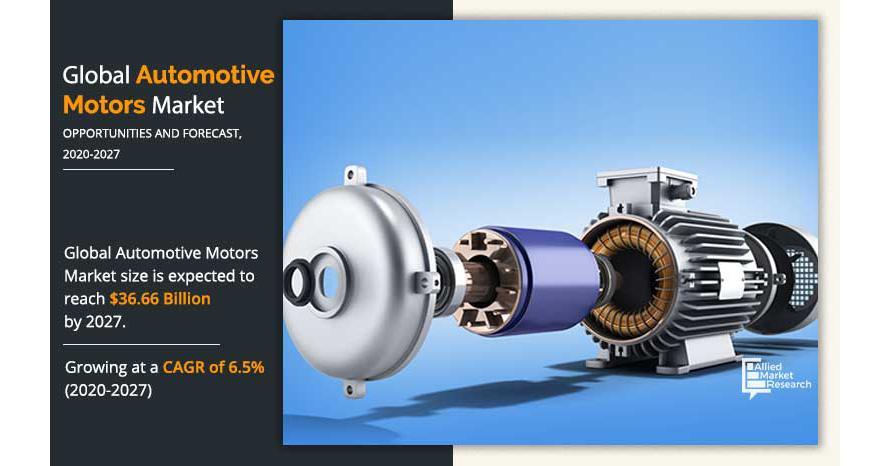According to a recent report published by Allied Market Research, titled,“automotive motors market by Type, Vehicle Type, Function, Technology, and Application: Opportunity Analysis and Industry Forecast, 2020–2027”, the automotive motors market was valued at $28.72 billion in 2019, and is projected to reach $36.66 billion by 2027, registering a CAGR of 6.5% from 2020 to 2027.
Request Sample PDF at:
There numerous applications, which incorporate a motor for its function such as windshield wipers, sun roof, HVAC blowers, power seats, ventilated seats, power windows, sliding doors, folding side mirrors, fuel pump, water pump, power steering, radiator fan, engine fan, steerable headlights, door locks, and more. Each successive model of a vehicle brings additional safety features, better intelligence, and more convenience, which lead to the increase in use of motors in vehicles. For instance, a typical modern car on American road might easily include at least a dozen to 40 or more electric motors. Therefore, such applications, which employ the use of electric motors, are opportunistic for the key players operating in the automotive motors market.
Covid-19 scenario-
The outbreak of the pandemic led to huge disruption in the manufacturing units across the world. Also, the unavailability of skilled labor impacted the global automotive motors market negatively.
However, as the lockdown has slackened off in most of the countries, the market is expected to recuperate soon.
Interested to Procure the Research Report? Inquire Before Buying –
Autonomous vehicles, also known as self-driving vehicles, use artificial intelligence (AI) software, light detection & ranging (LiDAR), and RADAR sensing technology, which are further used to monitor a 60-meter range around the car and to form an active 3D map of the current environment, which is fueled by the use of electric motors.
The vehicle is designed to travel between destinations without a human operator. Moreover, a lot of gas is burned when driving at high speeds, braking, and re-accelerating excessively. Self-driving vehicles use less battery capacity and consume less gas, which result in less pollution. This adds benefits to make it suitable for the environment.
Introduction of smart cities, rise in demand for connected cars using Internet of Things (IoT), and reduction in traffic congestion are the factors that drive the market growth. In addition, development in the automotive sector, demand for luxury cars, and government regulations are expected to create numerous opportunities for the key players operating in the global automotive motors industry .
Key Findings Of The Study
In 2019, by type, the DC brushed motors segment generated the highest revenue.
In 2019, by vehicle type, the passenger cars segment was the highest revenue contributor.
In 2019, by function, the comfort & convenience segment was the highest revenue contributor.
In 2019, region-wise, Asia-Pacific contributed the highest revenue, followed by Europe, North America, and LAMEA.
The key players analyzed in the report include BorgWarner Inc., Continental AG, DENSO CORPORATION, Johnson Electric Holdings Limited, Mitsuba Corporation, MABUCHI MOTOR CO., LTD., Nidec Corporation, Robert Bosch GmbH, Siemens AG, VALEO, Inteva Products, LLC, Magna International Inc, Marelli Europe S.P.A., Aptiv PLC, Buhler Motor, Meritor, Inc., PST Electronics Ltd, and U-SHIN ltd.






Comments are closed.